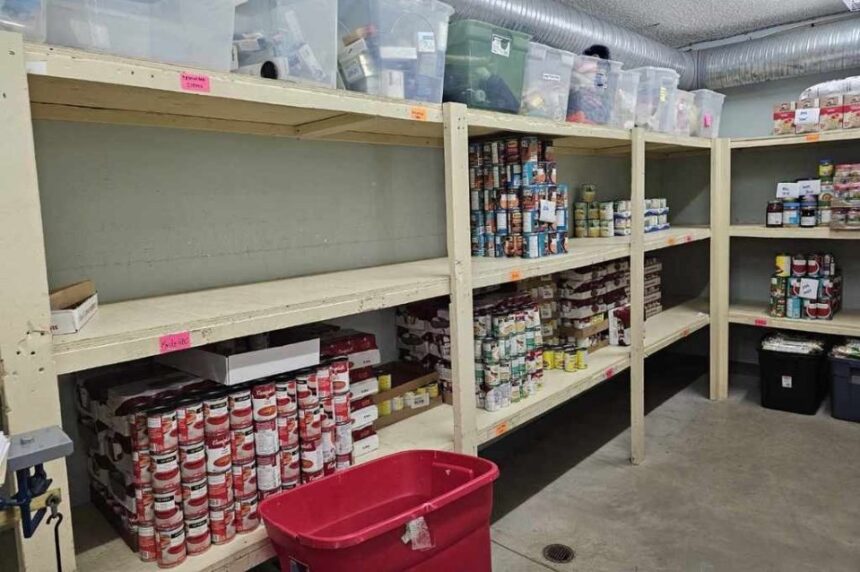I stepped into the Estevan Food Bank on a quiet Tuesday morning, where the usual bustle of volunteers sorting donations had been replaced by a more somber activity – taking inventory of increasingly empty shelves. Stacked boxes of pasta that once reached the ceiling now barely covered the bottom row. The freezers, typically packed with donated meat, stood half-empty.
“We’re seeing more families every week, but our supplies aren’t keeping pace,” explained Marilyn Simons, the food bank’s operations manager, as she showed me around the facility. “Our regular donors are feeling the pinch themselves.”
The Estevan Food Bank is facing what staff describe as a “perfect storm” of challenges: rising food costs, increased client numbers, and decreased donations. Last month alone, they served 217 households – a 34 percent increase compared to the same period last year.
Saskatchewan’s economic landscape has created ripple effects that reach beyond the energy sector that once defined Estevan’s prosperity. While the provincial unemployment rate hovers at 5.7 percent according to Statistics Canada’s latest labour force survey, Estevan’s rate sits nearly two points higher at 7.5 percent.
“We’re seeing people we’ve never seen before,” Simons noted. “Working families who simply can’t stretch their paycheques any further, seniors on fixed incomes, and recently laid-off workers waiting for their first EI payment.”
Food Banks Canada’s HungerCount 2023 report confirms this isn’t just an Estevan problem. Nationally, food bank usage has increased by 78 percent since 2019. Saskatchewan’s increase mirrors this trend, with rural communities often experiencing more severe impacts due to limited resources and transportation barriers.
The shelves at Estevan’s food bank tell a story that statistics alone cannot capture. Certain staples – peanut butter, canned meat, baby formula – disappear almost as quickly as they arrive. Volunteers have started creating smaller hampers to ensure everyone receives something, but the nutritional balance these packages once offered is becoming harder to maintain.
“We used to provide enough food for about five days,” explained volunteer coordinator Sarah Henderson. “Now we’re struggling to cover three days for each family.”
Local businesses have historically been reliable supporters, but economic pressures have affected their ability to contribute at previous levels. The Coal Country Community Fund, which channels resources from area companies to local charities, reported a 22 percent decrease in corporate donations compared to 2022.
Mayor Roy Ludwig acknowledges the challenges facing his community. “Estevan has weathered tough times before, but the combination of energy sector transitions and pandemic aftermath has created unique pressures on our most vulnerable residents,” he told me during our conversation at City Hall.
The situation has prompted creative responses. Local schools have launched monthly food drives with themed collections – “Protein February” encouraged donations of beans, peanut butter and canned meat, while “March Meal Makers” focused on pasta and sauce combinations.
St. Joseph’s Hospital staff organized a department competition that netted over 1,200 items last month. Even the Estevan Bruins hockey team got involved, offering discounted admission to fans who brought food donations to their last home game.
Yet despite these community efforts, the math remains challenging. Each household hamper costs approximately $75 to assemble with proper nutritional components. With 217 households served monthly, the food bank needs about $16,275 in food value each month just to maintain current service levels.
“We’re not just talking about hunger in the traditional sense,” explained Dr. Kara Peterson, a family physician who volunteers at the food bank’s weekly clinic. “We’re seeing nutrition-related health issues – diabetics unable to access appropriate foods, children with vitamin deficiencies, seniors cutting meals to afford medications.”
The provincial response has been limited. While the Saskatchewan government announced a one-time $20 million investment in food security initiatives last year, critics note this translates to approximately $18 per food bank user – barely enough for two days of meals.
NDP opposition critic Meara Conway pointed out during recent legislative debates that food bank usage increased during times of economic growth, suggesting structural problems beyond temporary economic downturns. “When working people can’t afford to eat despite holding jobs, we need to examine our social safety nets more closely,” Conway argued.
The Estevan Food Bank has launched an urgent summer appeal, hoping to raise $25,000 and collect 5,000 pounds of non-perishable items before September when school lunch programs resume. They’ve established collection points at local grocery stores, churches, and the public library.
“Summer is always our leanest season for donations,” Simons explained. “People are traveling, school programs are paused, and food drives decrease. But hunger doesn’t take a vacation.”
For Julia Martins, a single mother of three who started using the food bank four months ago after her hours at a local restaurant were cut, the service has been essential. “I never imagined I’d need this help,” she told me, requesting I change her name to protect her privacy. “I work, I budget carefully, but groceries just keep getting more expensive. Without the food bank, I’d have to choose between paying rent or feeding my kids properly.”
As I prepared to leave, I watched volunteers organizing the day’s hampers. They moved with practiced efficiency, making the most of limited supplies, occasionally setting aside special items for families with specific needs they’ve come to know – sugar-free options for diabetic clients, extra protein for a family with teenage athletes, baby food for new parents.
Simons handed me a list of most-needed items before I left: peanut butter, canned meat, baby formula, cooking oil, rice, and personal hygiene products. “We’ll stretch whatever comes in as far as possible,” she promised. “But we really need the community to step up now more than ever.”
The Estevan Food Bank accepts donations Tuesday through Thursday from 9 a.m. to 3 p.m. at their 1209 3rd Street location. Financial contributions can be made through their website, with tax receipts provided for donations over $20.






